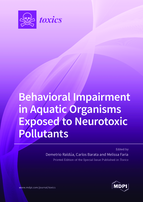Behavioral Impairment in Aquatic Organisms Exposed to Neurotoxic Pollutants
A special issue of Toxics (ISSN 2305-6304). This special issue belongs to the section "Ecotoxicology".
Deadline for manuscript submissions: closed (31 December 2021) | Viewed by 27484
Special Issue Editors
Interests: fish neurotoxicology; zebrafish model; fish developmental neurotoxicology
Special Issues, Collections and Topics in MDPI journals
Interests: analytical chemistry; aquatic toxicology; environmental risk assessment; toxicogenomics
Interests: toxicology; biomarkers; environmental science; biological science; behaviour and neurotoxicity
Special Issue Information
Dear Colleagues,
It has been estimated that up to 30,000 of commercially used chemicals may have neurotoxic potential. Neuroactive chemicals, including neurotoxic pesticides, pharmaceuticals, and illicit drugs, are the largest group of micropollutants present in European rivers, where nearly 30% of all detected chemicals were linked to neurotoxicity. Furthermore, neurotoxic actions of environmental contaminants on non-target species have been determined. It is suspected that such actions include changes in the behavior of organisms. For example, environmental pollutants such as trace metals and organic toxicants have been reported to increase fish susceptibility to predation, antidepressant drug altered sex mating behavior in fish, phototaxis and feeding in amphipods, cladocerans and worms, altered mobility of snails, memory, cognitive function, and the ability to camouflage in cuttlefish at environmental relevant concentrations.
This Special Issue on “Behavioral Impairment in Aquatic Organisms Exposed to Neurotoxic Pollutants” aims to highlight research on behavioral analysis in aquatic organisms using automated image analysis systems. Studies that anchor behavioral impairment with molecular markers, and also with population level effects will be preferred. Research addressing exposure to environmental relevant concentrations of pollutants will receive priority. Methodological studies developing new tools for the automated behavioral analysis in aquatic organisms are also encouraged.
Authors are invited and welcome to submit original research papers, reviews, and short communications.
Dr. Demetrio Raldúa
Dr. Carlos Barata
Dr. Melissa Faria
Guest Editors
Manuscript Submission Information
Manuscripts should be submitted online at www.mdpi.com by registering and logging in to this website. Once you are registered, click here to go to the submission form. Manuscripts can be submitted until the deadline. All submissions that pass pre-check are peer-reviewed. Accepted papers will be published continuously in the journal (as soon as accepted) and will be listed together on the special issue website. Research articles, review articles as well as short communications are invited. For planned papers, a title and short abstract (about 100 words) can be sent to the Editorial Office for announcement on this website.
Submitted manuscripts should not have been published previously, nor be under consideration for publication elsewhere (except conference proceedings papers). All manuscripts are thoroughly refereed through a single-blind peer-review process. A guide for authors and other relevant information for submission of manuscripts is available on the Instructions for Authors page. Toxics is an international peer-reviewed open access monthly journal published by MDPI.
Please visit the Instructions for Authors page before submitting a manuscript. The Article Processing Charge (APC) for publication in this open access journal is 2600 CHF (Swiss Francs). Submitted papers should be well formatted and use good English. Authors may use MDPI's English editing service prior to publication or during author revisions.
Keywords
- Behavioral analysis
- Neuroactive chemicals
- Neurotoxicity
- Neuroendocrine disruption
- Environmental relevant concentrations
- Aquatic organisms









